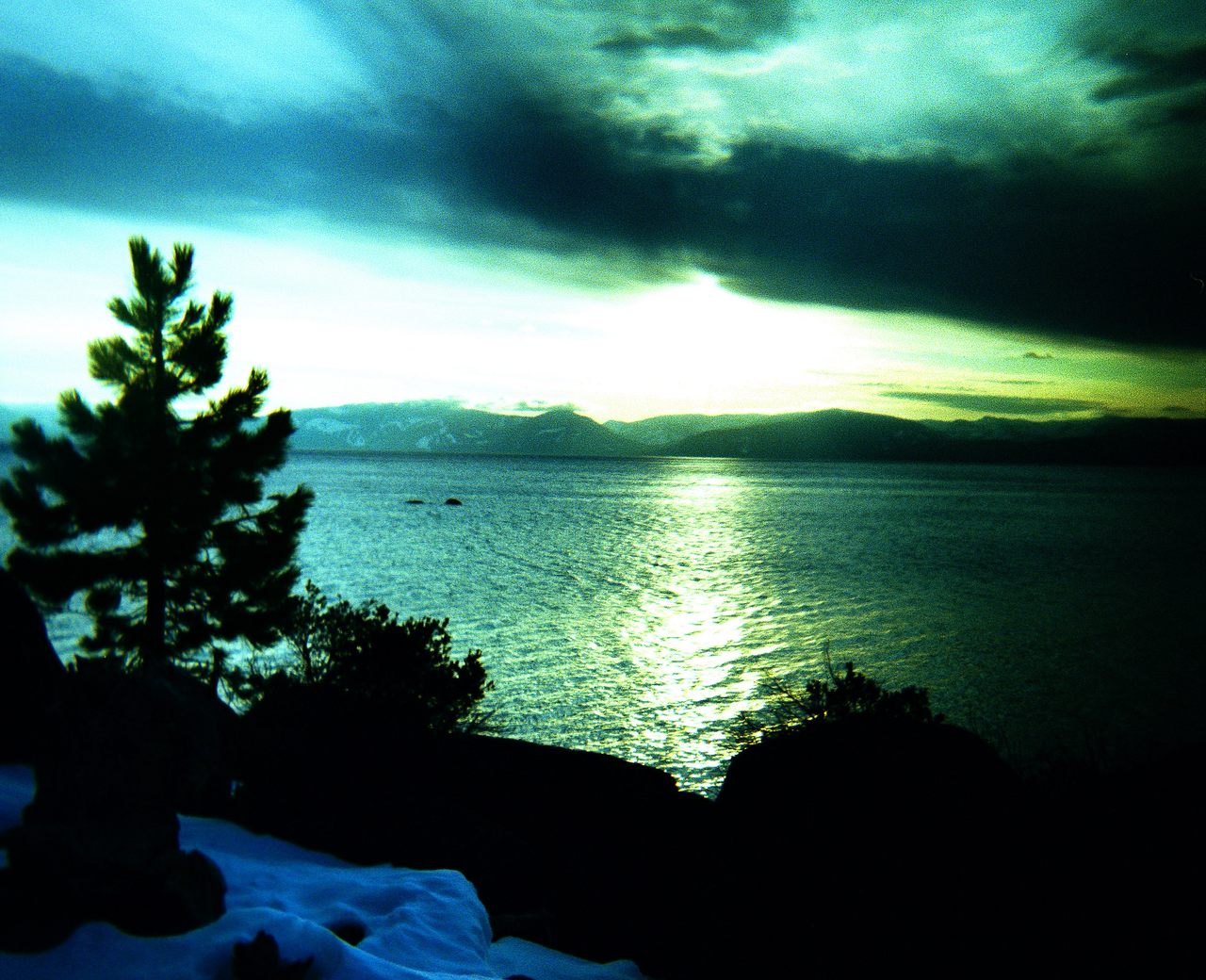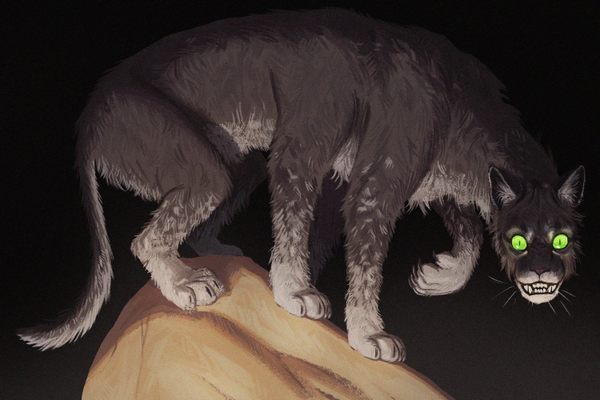The Loch Ness Monster Look-Alike Lurking Beneath Lake Tahoe
Legends of Tahoe Tessie go back centuries.
Legendary cryptids seem to roam every remote corner of the globe, from the yeti of the snow-capped Himalayas to the Mongolian death worm of the Gobi Desert’s unforgiving sands. But among these cryptids, perhaps the most well-known is the elusive lake monster. These plesiosaur-like creatures are said to dwell in numerous lakes, from Scotland’s Loch Ness to Argentina’s Nahuelito to the West Coast’s own Tahoe Tessie (a not-so-creative homage to her Scottish sibling).
Rumored to haunt the depths of Lake Tahoe, which drops more than 1,600 feet between California and Nevada, Tessie first came into discussion in the mid-1800s, though her roots may go back thousands of years. Today, Tessie’s Disneyfied, dinosaur-like image adorns T-shirts and children’s coloring books—but dismissing Tessie as a mere marketing ploy oversimplifies a long history associating Lake Tahoe with the unknown.
The earliest stories about Tahoe come from the Indigenous Washoe (or Wašiw). Many stories about the history and culture of the Washoe were lost with the arrival of white settlers in the 1830s, but the Washoe legend of “water babies” has remained. The powerful spirits, believed to inhabit various bodies of water in the region, resided near De ek Wadapush, or Cave Rock—a 300-foot monolith jutting into the lake’s depths and considered sacred to the Washoe. The well-known story speaks to the longstanding association between the lake and unknown entities and could have laid the groundwork for later interpretations that morphed into the modern-day legend of Tessie. (Record-keeping in Tahoe was generally poor until the Sierra Nevada became a popular recreation destination in the 1950s.)
J.A. Hernandez, a horror author and writer who has extensively researched various cryptids, including Tahoe Tessie, suggests Tessie’s origins might lie in misinterpretations of Washoe oral tradition. Citing obscure, out-of-print works on Washoe history, Hernandez points to references like those found in anthropologist James F. Downs’s 1966 book, The Two Worlds of the Washo. Downs mentions a Washoe belief in a “mysterious and malevolent water baby spirit” inhabiting the Carson River and “a monster” near a sacred spring. Hernandez argues these descriptions, filtered through the lens of early settlers unfamiliar with Washoe culture, could have morphed into the present-day legend of a physical creature.

Alternatively, he points to a paragraph about emigrant wagon trains in the Washoe Tribe’s 2021 historical publication that reads: “The Washoe describe seeing the wagons and wondering if they were a ‘monster snake.’” Wagon trains moving through the Sierra would have looked like a long snake from above, so it’s possible that the metaphorical snake became a real one as stories were passed on through generations. And since records suggest the cannibalism employed by the nearby Donner Party in the 1840s alarmed Tahoe-area tribes, it’s not a stretch to see where the “monster” part of the story may have come from. Or at least that’s Hernandez’s theory.
“The earliest supposed sighting of a serpent-like lake monster I could find was attributed to 19th-century settlers, right around the same time as the Donner Party passed through,” Hernandez says. “Unfortunately, just like the rest of the theories out there [about Tessie’s origin], there is no way to confirm it.”
What can be confirmed, however, are newspaper archives from the mid-1860s around Lake Tahoe, which are the first historical accounts of a lizard- or dinosaur-type monster in the lake.
A colorful account from the November 21, 1897 edition of the San Francisco Call and Post recounts an encounter in 1865 between I.C. Coggin, a wealthy San Francisco resident and manager of the illustrious Golden Gate Park Band, and the creature. It predates the “Tessie” moniker; the beast was described as an “unpleasant serpent” boasting a 14-foot-wide head, black scales, and a colossal body exceeding 600 feet in length. This seems to be the first reference to a Tahoe lake monster looking somewhat like a plesiosaur, and it’s probably not a coincidence that it happened when it did.
In 1824, an Oxford University professor first went on the record as suspecting the bones scientists and researchers had been digging up belonged to an extinct, oversized species. (Before that, it was thought dinosaur and megafauna bones were from ancient giant humans or unicorns, among other explanations). In 1823, self-taught British paleontologist Mary Anning found the first complete plesiosaur skeleton, described as “resembling a turtle in the shape of its paddles” and with more than 40 vertebrae. Sketches displayed for the Geological Society of London based on Anning’s find could have been Coggin’s inspiration for the 600-foot serpent he reported encountering in Tahoe.

All was quiet on the Tahoe lake monster front for almost a century, save for a few short newspaper articles. A 1959 story in the Reno Gazette-Journal about the Loch Ness Monster mentioned that most legends about a Tahoe monster were “lost in Indian lore.” And in 1963, a cartoon in the San Francisco Examiner depicted Tahoe’s growing pollution problem as looking very similar to depictions of the Loch Ness Monster.
In July 1984, the Fresno Bee drew some attention when it published an article citing Lake Tahoe monster sightings from June of that year and June 1982. In both cases, multiple witnesses saw a creature “at least 12 feet long” and “at least 17 feet long”—but interestingly, both groups interpreted it through a modern-day scientific lens, reporting it as a very large fish, rather than a mythical monster. In August of that year, a group of cryptozoologists reached the same conclusion, saying that a large sturgeon was likely the best explanation for the “Tahoe monster” sightings. That same day, a Virginia newspaper published a similar article, entitled, “Maybe they call it Tahoe ‘Tessie,’” and the moniker seems to have stuck.
Today Tahoe Tessie has shed any former fangs or claws, transforming into a kid-friendly icon trademarked in the 1980s. The friendly, cartoonish depictions are a far cry from the fearsome monster Coggin claimed to see in 1865. But they still perpetuate Tahoe’s long-standing mystique.
“After spending so much time on the lake, there’s definitely something more about it,” says Colin West, CEO of the local non-profit Clean Up the Lake. In Lake Tahoe, “there’s more going on than meets the eye, or than you’d expect to be real.”

West estimates he’s done more than 200 dives to collect litter in Lake Tahoe, reaching depths of 90 feet. Despite his extensive experience in the lake, West has never seen the fabled Tessie. Nonetheless, the lake carries other mysteries. There’s the legend of eccentric 1960s playboy George Whittell accidentally sinking his pet elephant in the lake, or the legend of the esteemed underwater documentarian Jacques Cousteau seeing something so terrible below the surface of Lake Tahoe he vowed to never speak of it again. Both tales are verifiably false (Whittell sent his elephant back to his compound in San Francisco, and Cousteau never visited Lake Tahoe)—but they still come up, says West, when divers are about to jump into the water. The sheer vastness of Tahoe’s unexplored depths, he says, makes it hard not to associate it with the unknown.
West describes moments during cleanup dives where seemingly normal things—unusual patterns in the lake bottom or branches of petrified trees—start to creep him out, making him a little more alert and anxious than normal. “There have been times when I’ve found myself a little too far from my dive buddy, and I’m hanging over an edge underwater that goes 1,000 feet deep, and yeah, you feel a little spooked out.”
West works with scientific research partners all the time and acknowledges the implausibility of a plesiosaur inhabiting the isolated freshwater lake. He attributes most “sightings” to mundane explanations, such as windblown debris and logs propelled off the shoreline by Tahoe’s frequent winter storms, creating the illusion of long, serpentine forms.
However, his extensive experience with the lake makes him hesitant to rule out any yet-to-be-discovered phenomena. “What does it look like from 100 to 1600 feet deep? Who knows? It could be quite different. It’s a big lake. Tahoe Tessie, I don’t know. But something else weird going on that has made people see things? Could be.”












Follow us on Twitter to get the latest on the world's hidden wonders.
Like us on Facebook to get the latest on the world's hidden wonders.
Follow us on Twitter Like us on Facebook